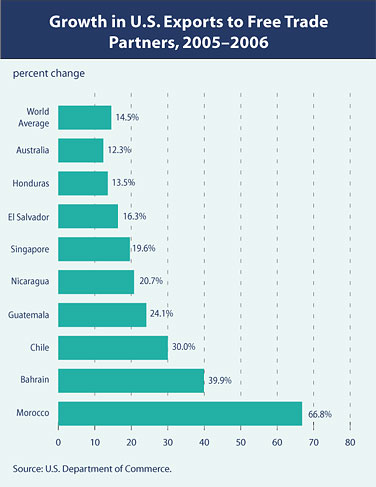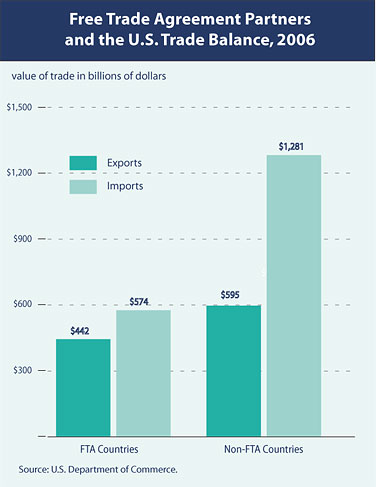|
|
|
|||||||||
|
2006 Was a Record Year for U.S. Exporters U.S. exporters are competing and winning in international markets. by David Levey U.S. exports grew at a robust rate in 2006 according to figures released in February by the Census Bureau. Last year, total U.S. exports grew by 12.7 percent to $1.4 trillion, an increase of $162.6 billion over 2005, while imports increased 10.5 percent to $2.2 trillion. Also in 2006, merchandise exports grew 14.5 percent to $1.0 trillion, while services exports expanded 8.8 percent to $414.0 billion. (Story continues below.)
International trade is an increasingly important part of the U.S. economy. In 2006, exports made up 11.1 percent or $1.4 trillion of U.S. gross domestic product (GDP)—the highest ever increase. By comparison, this figure stood at 5.2 percent in 1956 and 9.6 percent in 2002. “Our booming export numbers show the competitiveness of American workers and companies,” said Secretary of Commerce Carlos M. Gutierrez on the release of the latest trade statistics. “Our companies send more U.S. products to more international markets than ever. Our nation’s prosperity is dependent on engaging and winning in international markets.” Fast-Growing Export Sectors Among the fastest-growing sectors in manufacturing exports were capital goods, such as airplanes, semiconductors, and industrial machines; industrial supplies, such as petroleum products, organic chemicals, and precious metals; and automotive vehicles, parts, and engines. In services, travel and passenger fares stood out, with a record $107.4 billion in receipts last year. Exports to China and Other Developing Markets In 2006, one of the most important export trends was the continued boom in trade with advanced developing countries such as China, India, and Brazil. Ten years ago, exports to China were $12.0 billion. Today, China is the fourth-largest export market for the United States, as well as the second-largest trading partner. Exports to China grew by 31.7 percent to $55.2 billion in 2006. In context, U.S. exports to China were greater than exports to Argentina, France, Italy, Russia, and Spain combined. U.S. exports to India increased by 26.3 percent in 2006, while exports to Brazil increased by nearly as much to 25.1 percent. Among the industries that made headway last year in those challenging markets were the energy sector (such as civilian nuclear technology), electrical machinery, organic chemicals, and aircraft and medical equipment. Significance of Free Trade Agreements Free trade agreements (FTAs) have proved to be one of the best ways to open up foreign markets to U.S. exporters. Today, the United States has FTAs with 13 countries. In 2006, six new FTAs were implemented: with Bahrain, El Salvador, Guatemala, Honduras, Morocco, and Nicaragua. Last year, trade with countries that the United States has FTAs was significantly greater than their relative share of the global economy. Although comprising 7.3 percent of global GDP (not including the United States), those FTA countries accounted for 42 percent of U.S. exports. U.S. trade with Chile provides a great example of the benefits of an FTA. Before the agreement with Chile in 2003, U.S. exports were $2.7 billion. Liberalizing trade in the intervening years has had a dramatic effect on trade volumes. By 2006, Chile became one of the top 30 U.S. export destinations, with nearly $6.8 billion in exports, a 30 percent increase over 2005 and a 150.1 percent increase since the FTA went into force. Not only has the volume of exports to Chile increased, but so has the U.S. share of Chile’s overall import market, which has risen from 14.5 percent in 2003 to 16.0 percent in 2006. Several U.S. industries have benefited from the trade growth with Chile, including high-tech, commodity, and finished goods, such as surgical equipment, airplanes, petroleum derivatives, and earthmoving equipment. Other Areas of Significant Export Growth FTA partners and advanced developing countries were significant sources of U.S. export growth in 2006, but they were not the only countries where U.S. exporters found new markets. (Story continues below.)
Many traditional trading partners saw more U.S. products at their docks and in their warehouses, with export growth seen in 29 of the top 30 U.S. export partners in 2006. For example, U.S. exports to Germany were up 20.9 percent, while exports to the United Kingdom, the largest European trading partner for the United States, increased 17.6 percent. Switzerland saw a 34.1 percent increase, and Turkey entered the top 30 markets with 34.2 percent growth. Prospects for Future Growth With the favorable exporting climate, 2007 promises to be another great year for U.S. trade abroad. As President George W. Bush remarked when he visited a Caterpillar Inc. plant in East Peoria, Illinois, on January 30, 2007, “The United States is 5 percent of the people in the world; that means 95 percent live outside of America. Shouldn’t we try to put ourselves in a position where we can sell goods and services to those 95 percent? I think it makes sense to do so.” David Levey is a writer in the Office of Public Affairs in the International Trade Administration.
|
|

